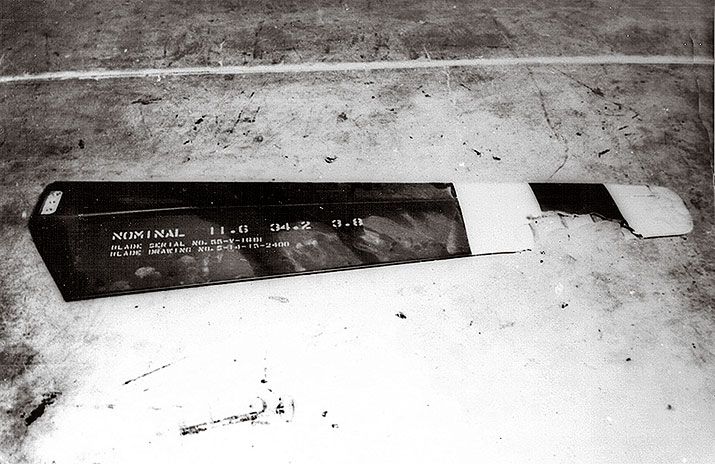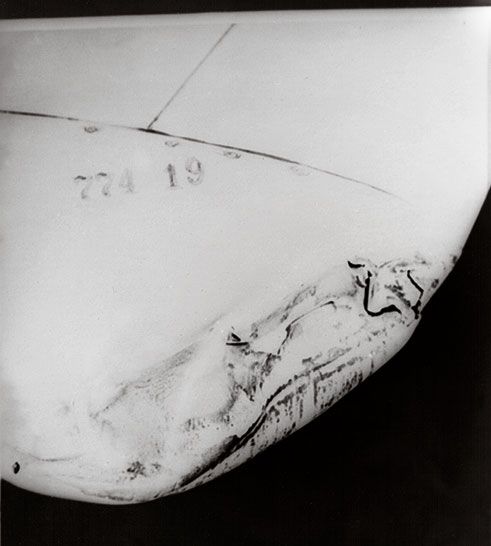Contact!
What happens when helicopters get a little too close.
/https://tf-cmsv2-smithsonianmag-media.s3.amazonaws.com/filer/Above-Beyond-helicopter-631.jpg)
Gray clouds hung low over Marine Corps Air Facility Santa Ana, California, the morning of October 2, 1952, as Captain Roy Thorson walked the ramp between rows of sea-blue Sikorsky helicopters. Thorson, my father, was a pilot for Marine Helicopter Transport Group 16, the Marine Corps’ first all-helicopter group, which comprised several squadrons. Its commander, Colonel Harold Mitchener, had selected Dad as his copilot.
Mitchener and Dad had met seven years earlier at Marine Corps Air Station Ewa, Hawaii, as World War II ended. Mitchener, then a major, was executive officer of Marine Aircraft Group 15, supporting the First Marine Air Wing in China. Dad was a young second lieutenant who had flown PBJs (the Marine Corps version of the North American B-25 Mitchell bomber), and he was waiting to return to the mainland. He flew local missions in R5C (Curtiss C-46) and R4D (Douglas C-47) transports amid mundane ground tasks like serving as mess officer, and his practiced manner in handling those duties endeared him to Mitchener.
Dad finally shipped home to California in April 1946, and was discharged as a first lieutenant. But when the Korean War started, he was recalled to active duty, and in March 1951 was flying transports at Marine Corps Air Station El Toro in California when he learned that pilots were needed for helicopter training.
He reported to Naval Air Station Ellyson Field near Pensacola, Florida, in June, completing training the next month. Arriving at the Marine Corps base in Santa Ana, he was pleased to find he’d been assigned to fly the new Sikorsky HRS, the Marine Corps version of the S-55, in a squadron commanded by his old acquaintance from Ewa: Harold Mitchener, now a colonel.
Promoted to captain in August 1951, my father was soon qualified in the big Sikorsky. The following year, the growing number of squadrons at Santa Ana merged into a group commanded by Mitchener, while the helicopter pilots tested the new combat tactic known as vertical envelopment (rotary-wingspeak for air mobility). Part of the testing would culminate in Operation PHIBEX, the largest amphibious exercise at California’s Camp Pendleton since World War II, involving 21,000 Marines, 150 Navy ships, and 100 aircraft, including the HRSs of Marine Helicopter Transport Group 16. The helicopters would rendezvous in San Diego eight days beforehand, aboard the aircraft carrier USS Valley Forge. Planned for their departure from Santa Ana was the largest helicopter formation flight to date, 28 in all.
Weather minimums for a formation flight were one-mile visibility and a 500-foot ceiling. By 10:25 a.m., the sky over Santa Ana was partially obscured by haze, reducing visibility to one mile. San Diego reported an 800-foot ceiling and 2.5 miles visibility. Mitchener decided to launch. He, my dad, and two passengers climbed into their helicopter. All 28 HRSs took off at 11:14 and flew southeast at 400 feet, maintaining visual contact with the ground. Twenty-five minutes later the formation reached the coastline, turned south, and immediately encountered lower ceilings and greatly reduced visibility. Mitchener could still see the coastline, but forward visibility was near zero. As he stated later, “Being unable to reverse my course because of the hills to my left and the large number of aircraft behind me, I elected to attempt to climb through the overcast. I notified the flight of my intention and started my climb. I could still see the beach line and decided to climb on my heading which I [radioed] to the flight as 200 degrees magnetic.”
Seconds later, things went from bad to worse. Looming out of the gray mist was another helicopter dead ahead.
Both pilots reacted immediately and instinctively. “An HRS appeared in front of and directly below us,” my father said in his statement. “The flight commander and I pulled the cyclic back and to the right but, due to the rate the other HRS was climbing, it was impossible to avoid contact. I saw a piece fly loose as our main rotor made contact with the tail section of the other HRS.” The helicopter shuddered as Mitchener announced the collision over the radio and began to descend. The helicopter broke out of the clouds at 200 feet and landed on the cliffs above Capistrano Beach, with two more HRSs from the formation following them down. Pilots and passengers of all three piled out to assess the damage.
When the formation had first entered the clouds, Major Walter Simpson; Simpson’s copilot, Captain Delpheus Sedgwick; and their two passengers, flying to Mitchener’s right, lost sight of Mitchener’s helicopter. Hearing Mitchener transmit that he was climbing, Simpson also began to climb. “I was in a slight bank to the left,” he stated. “I righted the [helicopter] and started to climb on a heading of 180 degrees.” Moments later, “I heard the Colonel transmit that someone had hit him. I broke out on top at around 1,300 to 1,400 feet, flew until I was clear of the [clouds], let down visually to 50 feet above the ground, and proceeded (south) toward San Diego.”
Back at the site where the three crews had landed, Mitchener and Dad discovered the only damage to their HRS was a dent in the tip of one main rotor blade, enough to have caused the vibration. Of greater concern was the possibility that the thick fog would cause further collisions among helicopters. The men would later learn that seven aircraft returned to Santa Ana, while 18 others descended below the clouds and proceeded to San Diego.
Among those 18 was the one carrying Simpson and Sedgwick. At their altitude, 50 feet, they spotted the trio of helicopters on the bluff. “I landed to see if I could be of assistance,” stated Simpson. “Colonel Mitchener climbed up the side of [my helicopter] and asked if I knew what had happened to the [helicopter] that hit him. I replied that I didn’t know.”
Dad then noticed what the others had missed. Years later, he told me he shouted to Simpson, “Set your rotor brake!” and as the blades slowed to a halt, he had him look back at his tail rotor. “Simpson’s eyes got as big as saucers,” he recalled. Six inches from the tip of one of the two tail rotor blades, a 9.5- by 4-inch piece had been gouged out. Simpson’s helicopter was the other collider in the mid-air strike.
A main rotor blade and a tail rotor blade were dispatched from Santa Ana by truck—mechanics replaced both on site—and both aircraft continued to San Diego, landing aboard Valley Forge later that afternoon.
The eight Marines aboard the two helicopters knew just how close they had come to tragedy. Mere inches separated them from death or serious injury. In the accident report that followed, Mitchener accepted “full responsibility for leading the flight into the [clouds]. Had I elected to descend rather than climb, I feel sure the accident would not have occurred.” The accident board agreed, concluding that the primary cause of the accident was the flight leader’s deviation from his visual clearance. However, it added that “[w]hen [Mitchener] announced his intention to climb on a heading of 200 degrees, had the wingman (Major Simpson) adjusted his course accordingly, this accident probably would have been avoided.”
Eleven months later, in front of a Dayton, Ohio airshow crowd of 100,000 and under a clear sky, a formation of HRS helicopters had just made a simulated troop drop when the main rotor blade of one collided with the tail rotor blade of the HRS in front of it. Both plummeted to the ground. The two pilots survived; one helicopter was destroyed by fire, and the other was heavily damaged. The next morning, the Associated Press described the helicopter midair as “possibly the first in history.”
I think Dad beat them to the punch.
Craig Thorson has amassed some 17,000 hours in everything from Cessna 150s to Boeing 767s. He has flown in a helicopter but is sorry to say he has never piloted one.

